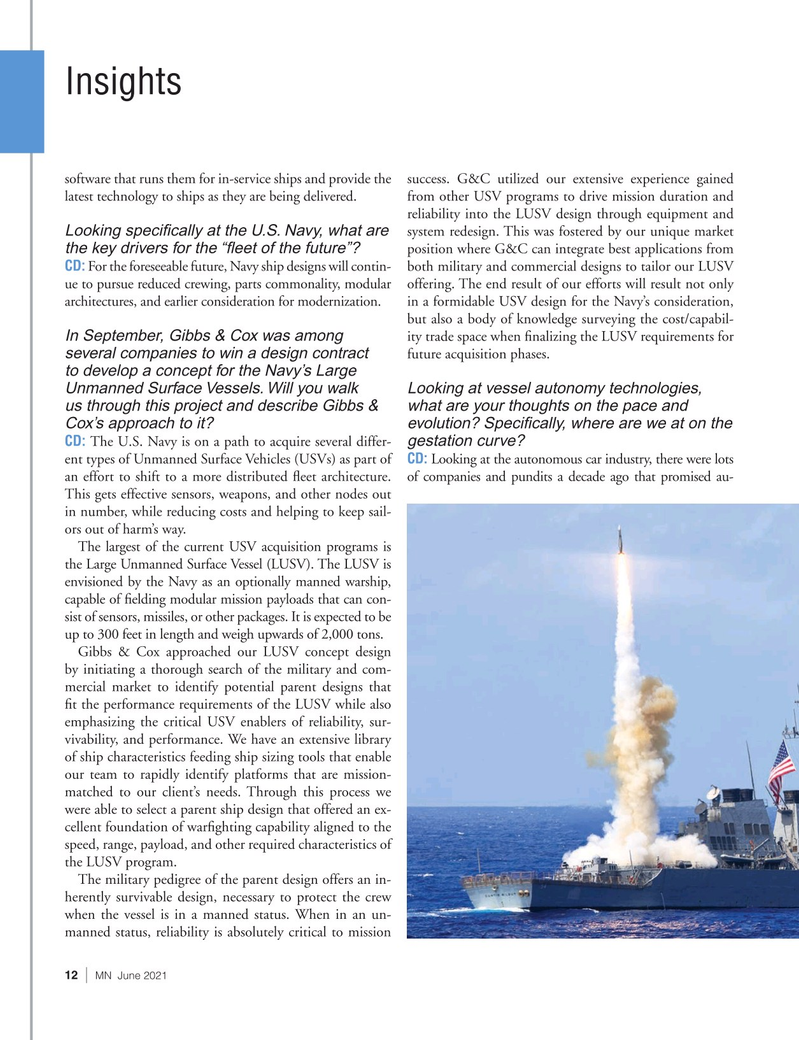
Page 12: of Marine News Magazine (June 2021)
Combat & Patrol Craft
Read this page in Pdf, Flash or Html5 edition of June 2021 Marine News Magazine
Insights software that runs them for in-service ships and provide the success. G&C utilized our extensive experience gained latest technology to ships as they are being delivered. from other USV programs to drive mission duration and reliability into the LUSV design through equipment and system redesign. This was fostered by our unique market
Looking speci? cally at the U.S. Navy, what are position where G&C can integrate best applications from the key drivers for the “? eet of the future”?
CD: For the foreseeable future, Navy ship designs will contin- both military and commercial designs to tailor our LUSV ue to pursue reduced crewing, parts commonality, modular offering. The end result of our efforts will result not only architectures, and earlier consideration for modernization. in a formidable USV design for the Navy’s consideration, but also a body of knowledge surveying the cost/capabil-
In September, Gibbs & Cox was among ity trade space when ? nalizing the LUSV requirements for several companies to win a design contract future acquisition phases.
to develop a concept for the Navy’s Large
Unmanned Surface Vessels. Will you walk Looking at vessel autonomy technologies, us through this project and describe Gibbs & what are your thoughts on the pace and
Cox’s approach to it? evolution? Speci? cally, where are we at on the gestation curve?
CD: The U.S. Navy is on a path to acquire several differ- ent types of Unmanned Surface Vehicles (USVs) as part of CD: Looking at the autonomous car industry, there were lots an effort to shift to a more distributed ? eet architecture. of companies and pundits a decade ago that promised au-
This gets effective sensors, weapons, and other nodes out in number, while reducing costs and helping to keep sail- ors out of harm’s way.
The largest of the current USV acquisition programs is the Large Unmanned Surface Vessel (LUSV). The LUSV is envisioned by the Navy as an optionally manned warship, capable of ? elding modular mission payloads that can con- sist of sensors, missiles, or other packages. It is expected to be up to 300 feet in length and weigh upwards of 2,000 tons.
Gibbs & Cox approached our LUSV concept design by initiating a thorough search of the military and com- mercial market to identify potential parent designs that ? t the performance requirements of the LUSV while also emphasizing the critical USV enablers of reliability, sur- vivability, and performance. We have an extensive library of ship characteristics feeding ship sizing tools that enable our team to rapidly identify platforms that are mission- matched to our client’s needs. Through this process we were able to select a parent ship design that offered an ex- cellent foundation of war? ghting capability aligned to the speed, range, payload, and other required characteristics of the LUSV program.
The military pedigree of the parent design offers an in- herently survivable design, necessary to protect the crew when the vessel is in a manned status. When in an un- manned status, reliability is absolutely critical to mission 12 | MN June 2021

 11
11

 13
13
